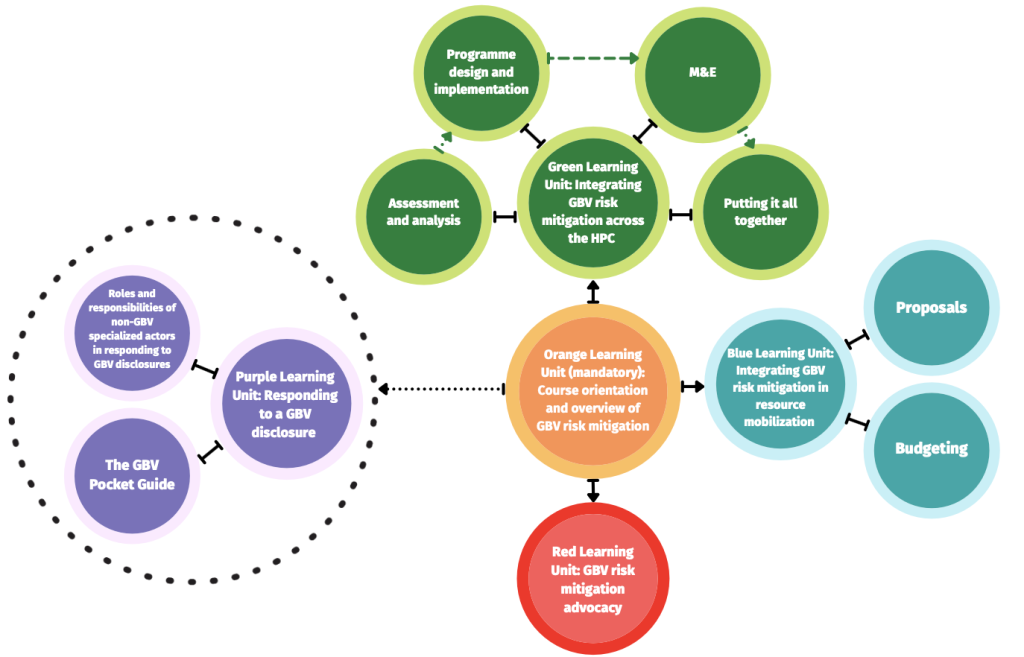Building upon more than five years of rolling out the IASC GBV Guidelines and four successful cohorts of the GBV risk mitigation online course (2021, 2022, 2023 in English and French), the inter-agency GBV Guidelines Reference Group[1] is pleased to announce an online course for non-GBV specialized humanitarian actors, on integrating GBV risk mitigation interventions in humanitarian action. This informational announcement offers an overview of the online course.
GBV risk mitigation comprises a range of activities within humanitarian response that aim to first identify GBV risks and then take specific actions to reduce those risks. ALL humanitarian actors, regardless of mandate or sector, have a responsibility to mitigate GBV risks in their work keeping with the Centrality of Protection and principle of Do No Harm.
Course applications will be accepted until 10 May 2024 through this form. Accepted participants will be notified by no later than 27 May 2024
This course is divided into a series of topic-specific learning units that will equip participants with the knowledge and practical skills to integrate GBV risk mitigation into humanitarian action. It is not mandatory to take all learning units. Applicants will be asked to indicate their preferred selections in the online course application.
The GBV risk mitigation online course will be run in real time and as such will be highly interactive.
[1] The GBV Guidelines Reference Group is comprised of approximately 15 member agencies: Action Against Hunger, CARE, CDC, GBV AoR, IMC, IOM, Irish Consortium on GBV, IRC, NRC, Oxfam, Save the Children, UNFPA, UNHCR, UNICEF, WFP, and WRC.
| Unit | Topic | |
|---|---|---|
| Orange learning unit | Mandatory | Course orientation & overview of GBV risk mitigation |
| Green learning unit | Optional | Integrating GBV risk mitigation across the Humanitarian Program Cycle |
| Blue & Red learning units | Optional | Integrating GBV risk mitigation in resource mobilization & advocacy |
Please see below for additional details on the flow of the course and the objectives of each of the learning units. An online course on responding to GBV disclosures will be announced separately and run later this year.
This course is designed for NON-gender/GBV or Protection specialized staff. Humanitarian staff from all other technical sectors (i.e.: Food Security, WASH, Shelter…) with an interest to learn more about GBV risk mitigation are encouraged to apply.
The e-learning course will be accompanied by roughly weekly one-hour webinars or office hours delivered by subject matter expert facilitators. The selected cohort will learn together, from the facilitators and from each other - via videos, assignments, webinars, discussions and peer group work – throughout the duration of the course. Between self-paced e-learning and weekly webinars, it is anticipated that participants will need to spend approximately 5-6 hours per week on the course in total. Flexibility will be built in for major holidays that occur during the duration of the course.
This course has been offered in English and French and the 2024 course will be offered in Spanish.
PARTICIPATION COSTS
With generous support from CARE, this course is free of cost and open to all NON-gender/GBV/protection specialized humanitarian staff across all sectors around the globe.
APPLICATION DEADLINE
Course applications will be accepted until 10 May 2024 through this form. Accepted participants will be notified by no later than 27 May 2024.
As noted above, this course is divided into a series of topic-specific learning units that will equip participants with the knowledge and practical skills to integrate GBV risk mitigation into humanitarian action. This annex provides additional details on the flow of the course and the specific learning objectives of the GBV risk mitigation online course learning units.


By the end of the Orange (orientation) learning unit (this one), learners should be able to:
PLEASE NOTE: The Orange unit is the only mandatory unit, however, it MUST be paired with at least one of the other units. It is not possible to take the Orange unit as a standalone. If your application to this course is successful, you must enroll in the Orange unit AND at least one other learning unit.

By the end of the Green (HPC) learning unit, learners should be able to:

By the end of the Blue (resource mobilization) learning unit, learners should be able to:
NOTE: the blue and red learning units will be combined for the 2023 course offering.

By the end of the Red (advocacy) learning unit, learners should be able to:
NOTE: the blue and red learning units will be combined for the 2023 course offering.
This site is always being updated, so please check back often for new additions, tools, and resources!
Copyright © 2024 • GBV Guidelines
